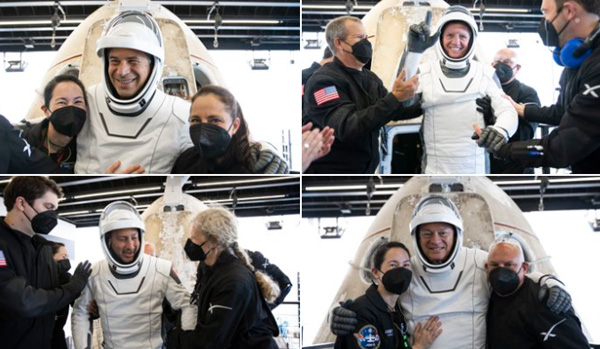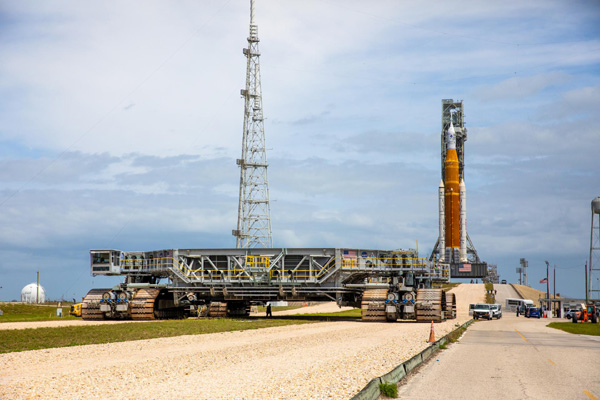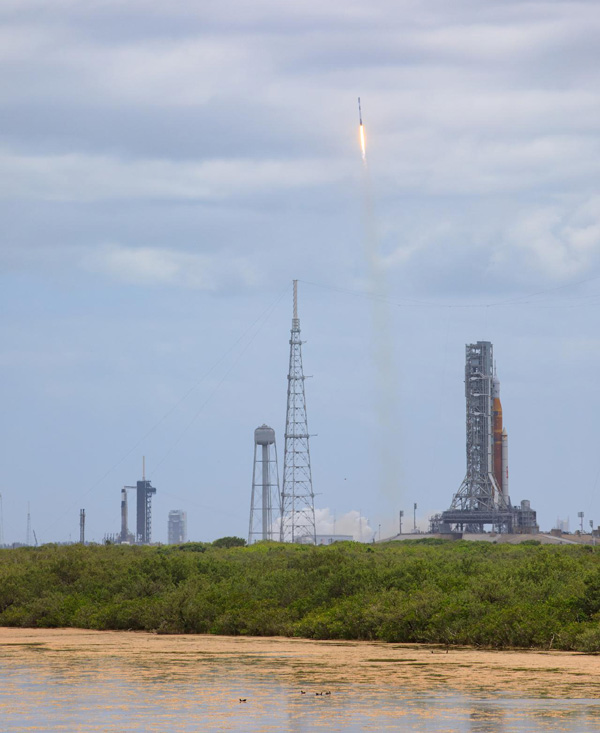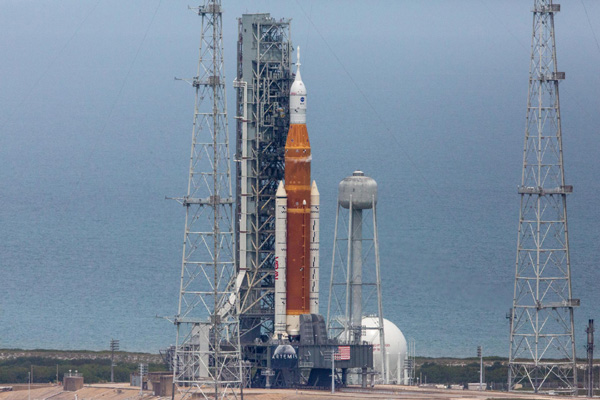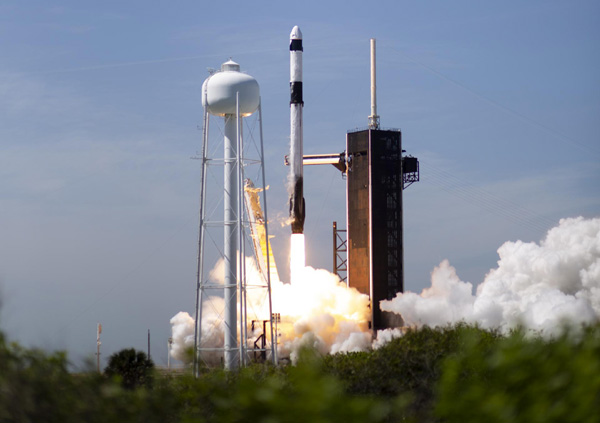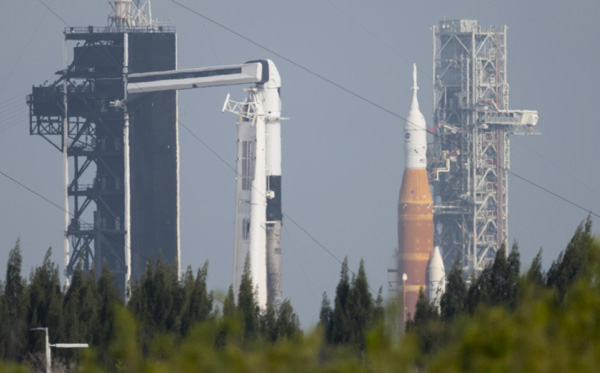
NASA / Kim Shiflett
NASA’s SpaceX Crew-4 Astronauts Launch to International Space Station (Press Release)
NASA’s SpaceX Crew-4 astronauts are in orbit following their launch to the International Space Station at 3:52 a.m. EDT Wednesday, April 27, from Launch Complex 39A at NASA’s Kennedy Space Center in Florida. The international crew of astronauts will serve as the fourth commercial crew rotation mission aboard the space station.
A SpaceX Falcon 9 rocket propelled the Dragon spacecraft into orbit carrying Mission Commander Kjell Lindgren, Pilot Bob Hines, and Mission Specialist Jessica Watkins, all NASA astronauts, and Mission Specialist Samantha Cristoforetti of ESA (European Space Agency). The crew will conduct a science expedition in microgravity aboard the space station.
“Liftoff! The past few days at Kennedy Space Center have been inspiring and busy with the return of the Axiom crew and now the successful launch of Crew-4 astronauts to the International Space Station,” said NASA Administrator Bill Nelson. “Aboard station, Kjell, Bob, Jessica, and Samantha will carry out research investigations that will help NASA prepare for longer duration stays on the Moon – and eventually Mars. These missions wouldn’t be possible without the dedicated NASA and SpaceX teams here on Earth. Godspeed, Crew-4!”
This Crew-4 mission is the first launch for Hines and Watkins, and the second flight to the station for Lindgren and Cristoforetti. It launched in a new Dragon spacecraft, named Freedom by the crew, and a Falcon 9 booster flying its fourth mission into space. This is the fifth SpaceX flight with NASA astronauts – including the Demo-2 test flight in 2020 to the space station – as part of the agency’s Commercial Crew Program.
During Dragon’s flight, SpaceX will monitor a series of automatic spacecraft maneuvers from its mission control center in Hawthorne, California, and NASA teams will monitor space station operations throughout the flight from the Mission Control Center at the agency’s Johnson Space Center in Houston.
Dragon will dock autonomously to the space-facing port of the station’s Harmony module around 8:15 p.m. Wednesday, April 27. NASA Television, the NASA app, and the agency’s website are providing ongoing live coverage through docking, and hatch opening. NASA also will cover the ceremony to welcome the crew aboard the orbital outpost about 2:40 a.m. on Thursday, April 28.
“NASA, SpaceX and our international partners have worked tirelessly to ensure that the International Space Station continues conducting important research in microgravity, and working on a whole host of activities that benefit humanity and opens up access to more people in space,” said Kathryn Lueders, associate administrator for NASA’s Space Operations Mission Directorate in Washington. “Crew-4’s launch, less than two days after the return of the first all-private mission to station, exemplifies the spirit and success of the Commercial Crew Program to help maximize use of low-Earth orbit for years to come, testing the technologies we need for the Artemis program and beyond.”
Lindgren, Hines, Watkins, and Cristoforetti will join the space station’s Expedition 67 crew of Raja Chari, Thomas Marshburn, and Kayla Barron, all NASA astronauts, Matthias Maurer of ESA, and cosmonauts Oleg Artemyev, Sergey Korsakov, and Denis Matveev of Roscosmos. For a short time, the number of crew aboard the space station will increase to 11 people until Crew-3 astronauts Chari, Marshburn, Barron, and Maurer return to Earth a few days later.
Crew-4 is the third commercial crew mission to fly an ESA astronaut.
“It gives me great pleasure to see the successful launch of Samantha Cristoforetti and her Crew-4 colleagues. Samantha will take over from Matthias Maurer and continue to represent Europe and support European experiments aboard the space station throughout her mission,” says ESA Director General Josef Aschbacher.
ESA Director of Human and Robotic Exploration David Parker adds, “Samantha has been an excellent role model – even more so as on the space station she will take on the role of USOS lead, responsible for operations within the U.S. Orbital Segment of the International Space Station, comprising of American, European, Japanese and Canadian modules and components.”
The Crew-4 astronauts will spend several months aboard the space station conducting new scientific research in areas such as materials science, health technologies, and plant science to prepare for human exploration beyond low-Earth orbit and to benefit life on Earth.
The Crew-4 mission continues NASA’s efforts to maintain American leadership in human spaceflight. Regular, long-duration commercial crew rotation missions enable NASA to continue the important research and technology investigations taking place aboard the station. Such research benefits people on Earth and lays the groundwork for future exploration of the Moon and Mars, starting with the agency’s Artemis missions, which includes landing the first woman and person of color on the lunar surface.
Lindgren is commander of the Dragon spacecraft and the Crew-4 mission. He is responsible for all phases of flight, from launch to re-entry, and will serve as an Expedition 67 flight engineer. This will be Lindgren’s second spaceflight since becoming an astronaut in 2009. In 2015, he spent 141 days aboard the orbital laboratory as a flight engineer for Expeditions 44 and 45. Board-certified in emergency medicine, he previously worked at NASA Johnson as a flight surgeon supporting space station training and operations and served as a deputy crew surgeon for space shuttle flight STS-130 and Expedition 24. Lindgren was born in Taipei, Taiwan, and spent most of his childhood in England before graduating from the U.S. Air Force Academy.
Hines is the pilot of the Dragon spacecraft and second in command for the mission. He is responsible for spacecraft systems and performance. Aboard the station, he will serve as an Expedition 67 flight engineer. This will be his first flight since his selection as an astronaut in 2017. Hines has served more than 22 years in the U.S. Air Force as a test pilot, fighter pilot, and instructor pilot. Before his selection in 2017, he was a research pilot at Johnson.
Watkins is a mission specialist for Crew-4 and will work closely with the commander and pilot to monitor the spacecraft during the dynamic launch and re-entry phases of flight. Once aboard the station, she will seve as a flight engineer for Expedition 67. Watkins grew up in Lafayette, Colorado, and studied geology at Stanford University, Palo Alto, California, and the University of California, Los Angeles. As a geologist, she studied the surface of Mars and was a science team collaborator at NASA’s Jet Propulsion Laboratory near Pasadena, California, working on the Mars Science Laboratory rover Curiosity. She also was selected as a NASA astronaut in 2017, and this will be her first trip to space.
Cristoforetti will also serve as a mission specialist, working to monitor the Dragon spacecraft during the dynamic launch and re-entry phases of flight. She will serve as a flight engineer for Expedition 67. This will be her second trip to space following five months in 2015 as a flight engineer for Expeditions 42 and 43. Born in Milan, Italy, she was a fighter pilot in the Italian Air Force prior to being selected as an ESA astronaut in 2009. In 2019, she served as commander for NASA’s 23rd Extreme Environment Mission Operations mission on a 10-day stay in Aquarius, the world’s only undersea research station.
****

SpaceX

LifeShip
DIRECTLY ABOVE: LifeShip's biobank capsule—which contains the DNA samples of 500 plant and animal species, as well as those of 2,000 humans (including mine)—is now headed to the International Space Station courtesy of the Crew-4 mission!



